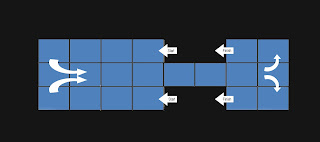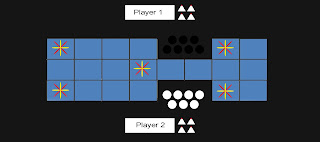Tools for
Creating Dramatic Game Dynamics
~ Notes on Marc LeBlanc
~
The power of games
as a story vehicle is not a new idea. Many acient games (such as
Senet) tell a story of passage through the underworld to the land of
the dead. In some cases of these games they are perceived to be
divination which tells you your story or possible outcome via the
game. This was covered in the Royal game of Ur studies as a possible
starting point of the game and maybe continued tradition throughout
its life cycle.
Creating drama within a
game is compounded by our limited control over the game we create.
This is because we don’t know or cant see how our game will play
out in precise detail each time it is played. We can only implement
mechanics and dynamics within a game to which create drama. You could
also say some aesthetics create drama and/or enhance its dominance
within a game such as Challenge in FPS games or Expression &
Discovery in the Final Fantasy series.
In order to discover ways
in which to make our game more dramatic we must understand how drama
usually works and how we see drama in stories, computer games,
movies, cards games etc. We use the dramatic arc for this which
visualizes the rising and falling of a well-told story.
The drama starts with
conflict which creates tension that will accumulate as the story
builds to a climax and then dissipates as the conflict is resolved.
This diagram is only used to explain how drama within a narrative
works, we cant actually measure tension but it is important to get a
idea of how it increases over time till the climax and then resolves
shortly after at a much quicker pace than the tension was built.
We can break down the
dramatic tension into to uncertainty and inevitability to better
understand how we can create tension, climax then resolve throughout
the narrative.
Uncertainty
Feedback System
as Sources of Uncertainty -
The game state is all the
information you would need to put in a save file for the game. This
includes scores, positions, location, items, health, bullets left
etc., anything needed to be known to continue the game in the same
state as it was when saved.
The scoring function is
the sensor of the cybernetic feedback system. This could be the score
of kill/deaths in a FPS game, or the distance between player 1 &
2 on a racing game. Its a means of measuring who is winning and by
how much.
The game mechanical bias
is the actuator of the cybernetic feedback system. This rule
determines which player gets an advantage over the other. For example
giving the losing race car a small speed boost to help catch up or
giving the lead scorer a bonus as reward.
The controller is the
comparator of the cybernetic feedback system. This rule chooses which
player receives the game mechanical bias and bases its decision on
the scoring function.
We can use this system to
create dramatic tension by driving the scoring function closer to
zero or a tie as this creates uncertainty and tension on the way to
the climax. The ultimate goal of this system is to keep the game as
even as possible to create the drama and tension throughout the game
and used as a safe guard against one player totally dominating the
game.
We can also use this
system in a positive way to aid the climax of the game. Due to the
mechanical bias used throughout play it can stagnate who is winning
or losing and we can ensure the climax is reached by giving the
mechanical bias to the leader to dispel the uncertainty of the end
result. We see this in many forms such as RTS games where you get
more resources if you win the battle over it or you get to pick up
all the speed boosts in Mario kart if your in first as no one is in
front taking them before you. This process dispels the dramatic
uncertainty and creates a sense of closure, preparing you for the win
and the losers to lose.
Pseudo-Feedback
Quite frequently,
these sorts of mechanism create game dynamics that appear as if the game were being driven by a negative feedback system when one
player takes the lead but quite frequently the other player(s) will
catch up. This is just a perception of a cybernetic feedback system
as there isn’t one.
Escalation - This
mechanic is when the score changes faster and faster over the course
of play, so that there are more points at stake at the end of the
game than at the beginning. This is best explained using game shows
were questions answered by teams are worth less at the start than
they are at the end. The lead team by half time may of answered more
questions and have more points but in the second half the behind team
answer only a few question correctly but draw scores or go ahead.
Hidden Energy - A
example of this would be a power boost you can use at your command
which is hidden from your enemy, much like nitro boost in racing
games or a absorb shield in fantasy shooting games. The lead player
may be ahead but that could be down to he/she has already used his
hidden power and the currently losers have not. This gives the
illusion of the leader winning until the other players use theirs the
outcome is uncertain.
Fog of War - This
represents a way of creating dramatic uncertainty by limiting the
information available to the players. At the beginning of the game,
players cannot predict the outcome of the contest because they aren't
given enough information. As the game progresses, more and more
information becomes available and the outcome of the game seems more
and more certain.
Cashing Out - This
is a game mechanic where the score of the game is reset to zero. Best
described in games such as bomberman where you have to win a set
amount of games to be declared the winner. Each time a new game is
started all players start on a even playing field and have just as
much chance of winning as each other. The only thing taken over from
each game is the score to the last winner of a game like a tally.
Inevitability
Uncertainty alone is
not sufficient enough to create dramatic tension, we also need
dramatic inevitability, the sense that the contest is moving forward
towards a conclusion (resolve). We can use mechanics to measure the
progress of a game as well as give a sense of how far away the end
might be, The players will feel propelled towards the conclusion of
the contest. Using timers or clock to measure time or count down time
is a example of this. Other mechanics that convey inevitability are a
ever increasing crowded game board, a dwelling deck of cards,
decreasing health bars or diminishing resources.
All of these give a sense
of progression through the game, warning us that the end is
approaching. We look at these as a type of ticking clock and the time
it is counting down is the resource that’s non-renewable. These
mechanics are a non-reversible processes which bring the game to its
conclusion while at the same time prohibiting backward movement. Its
important that for a ticking clock mechanic such as these to be
perceived as one, its must be apparent and understand as one by the
player(s).
Resolving
Dramatic Tension
The climax of the game
should occur at the moment of realization, when uncertainty is
dispelled and the outcome of the contest is known. Given this, the
climax should happen as late as possible to let tension build to make
a more dramatic climax occur. We need to ensure that the climax is
meet and all players know this otherwise it can be see to be left
unresolved at the end of the game. A clear winner or condition needs
to be meet.
My Thoughts
Great read, very
in-depth and informative. I found it fairly easy to relate a lot of
games and movies to this essay, especially the ticking clock and
resources mechanic to give a sense of inevitability and progression.
This reading made me think about the quote "it's not about the destination, it's about the journey" and I think its partly true
in the sense you need to build up the tension along the journey to
feel satisfied with the end result and using tools like this to
create a more dramatic dynamic/aesthetic to the game you can balance
and shape it depending on what play style you are going for.






















